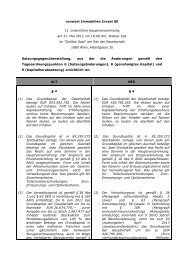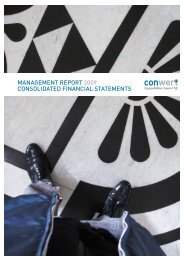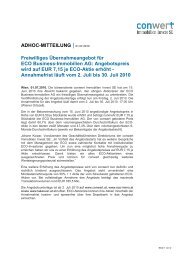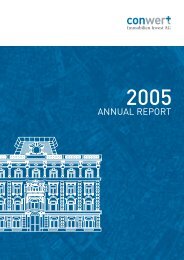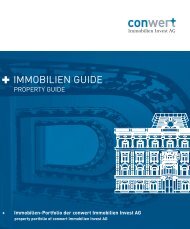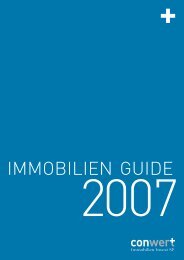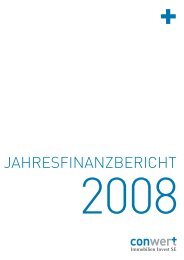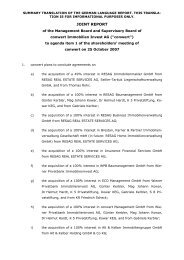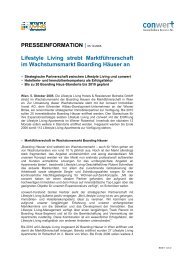annual financial statement 2011 - conwert Immobilien Invest SE
annual financial statement 2011 - conwert Immobilien Invest SE
annual financial statement 2011 - conwert Immobilien Invest SE
Create successful ePaper yourself
Turn your PDF publications into a flip-book with our unique Google optimized e-Paper software.
CONWERT IMMOBILIEN INVEST <strong>SE</strong><br />
ANNUAL FINANCIAL <strong>2011</strong> STATEMENT ANNUAL REPORT <strong>2011</strong><br />
60<br />
The following additional criteria are applied to specific assets:<br />
GOODWILL<br />
Goodwill is tested for impairment at least once each year. An impairment test is also performed<br />
when events or circumstances indicate that the carrying amount may be impaired.<br />
For the purpose of impairment testing, goodwill is allocated to cash-generating units. Impairment<br />
is determined by establishing the recoverable amount of the cash-generating unit to which the<br />
goodwill is allocated. The recoverable amount equals the relevant value in use, e.g. the present<br />
value of the future cash flows expected to be derived from the cash-generating unit. If the recoverable<br />
amount falls below the carrying amount of the cash-generating unit, an impairment loss<br />
is recognised; this impairment loss may not be reversed in a subsequent accounting period. Cashgenerating<br />
units are created by combining assets that generate independent cash flows. Additional<br />
information on this subject is provided under note 8.2.<br />
DEPRECIABLE, NON-CURRENT AS<strong>SE</strong>TS<br />
If there are objective indications that a depreciable non-current asset is impaired, an impairment<br />
loss is recognised equal to the difference between the carrying amount of the assets and its<br />
recoverable amount. The recoverable amount is determined on the basis of the value in use, i.e. the<br />
present value of the future cash flows expected to be derived from the asset. The carrying amount<br />
of the asset is then reduced through an adjustment account, and the impairment loss is recognised<br />
to profit or loss.<br />
If the amount of the impairment loss declines in subsequent reporting periods and this decline can<br />
be objectively attributed to circumstances that occurred after the recognition of the impairment<br />
loss, the previously recognised impairment loss is reversed (unless the asset represents goodwill).<br />
. However, the new carrying amount of the asset may not exceed depreciated cost at the time of the<br />
reversal. The reversal of the impairment loss is recognised to profit or loss.<br />
2.4.7. CASH AND CASH EQUIVALENTS<br />
Deposits with <strong>financial</strong> institutions are carried at their value as of the balance sheet date. Cash<br />
and cash equivalents as shown on the Group cash flow <strong>statement</strong> include the amounts shown for<br />
these items.<br />
2.4.8. FINANCIAL INSTRUMENTS<br />
Financial instruments are classified as <strong>financial</strong> assets or <strong>financial</strong> liabilities based on the economic<br />
characteristics of the relevant contract. Financial assets and liabilities are only netted out<br />
when there is a legal right to offset these amounts and plans call for settlement on a net basis or<br />
the settlement of the related liability concurrently with the realisation of the related asset.<br />
The fair value of <strong>financial</strong> investments that are traded in organised markets is determined by the<br />
quoted market bid price as of the balance sheet date. The fair value of <strong>financial</strong> investments for<br />
which there is no active market is established through valuation methods. These methods include<br />
recent business transactions between expert, willing and independent business partners as well<br />
as comparison with the current market value of a similar <strong>financial</strong> instrument and the analysis of<br />
discounted cash flows.<br />
The interest, dividends, gains and losses arising from these <strong>financial</strong> instruments are reported as income<br />
or expenses (excl. gains and losses on derivatives used for cash flow hedging – see note 8.10.3).



